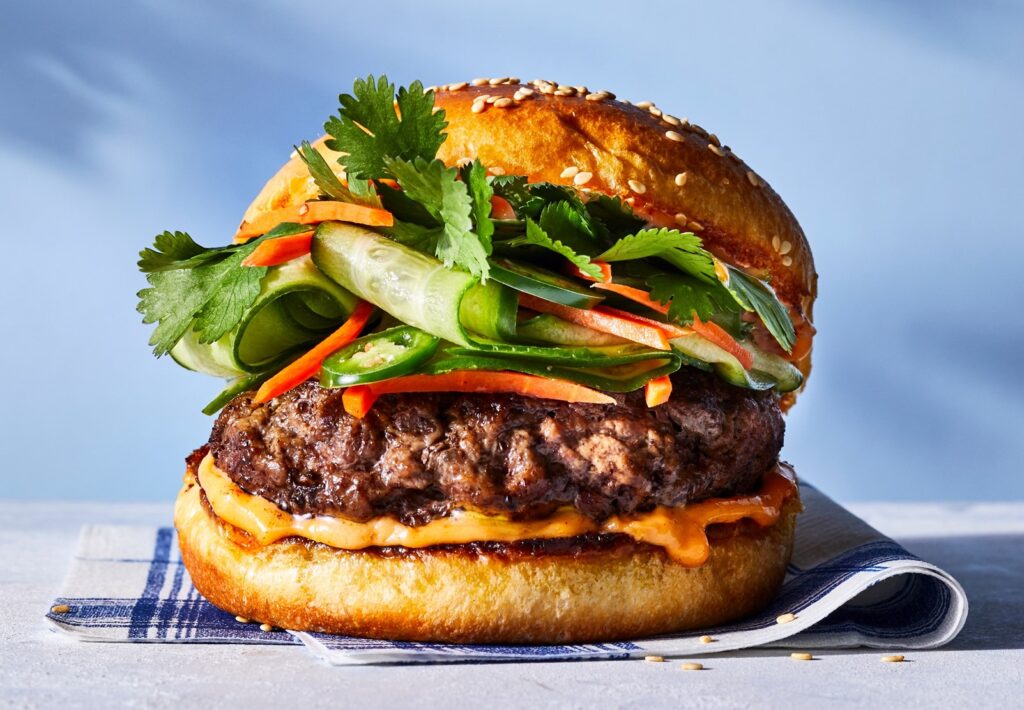Very good question. I saw this article, Implications of food ultra-processing on cardiovascular risk considering plant origin foods: an analysis of the UK Biobank cohort, by Rauber, et al. Wow! What a catchy title! It was on a post from my incredible colleague, Ginny Messina, @TheVeganRD. The article was published in The Lancet Regional Health – Europe. I thought to myself the Lancet? Cool, this will be interesting. I was looking to learn more about the health issues and the plethora of meatless, plant-exclusive burgers and faux animal products now on the market. No such luck.
What is a meatless, plant-exclusive burger?
Just to be sure we are all at the same lunch counter, a meatless burger does not have any animal products in the ingredients. That means no cows, pigs, chickens, etc. and no products from those sources such as eggs and milkfat.
Have veggie burgers changed in the last few years?
What happened to the veggie burgers that hit the scene in the 1980’s and 90’s? Remember the ones that were almost exclusively found in food coops and tasted more like a mishmash of vegetables and grains? The ones available before the 2020’s meatless, meat-like burgers showing up in the refrigerated and frozen sections from Whole Foods to Piggly Wiggly? Well, plant-based meat products is a $10.5B annual business that is looking to experience expansive growth. Another change has been an oozing addition of saturated fats. These fats give a more oily, meat burger mouth feel which makes them more palatable for the non plant-based eaters.
What’s the problem with Saturated Fats?
What’s a saturated fat? They are solid at room temperature – think butter, coconut oil or lard. Yes, coconut oil is just as nasty to your arteries as butter. Another fun fact – these are the fats that stick to your arterial lining and cause hardening of the arteries, heart attacks and strokes. They also assist in developing many cancers and type 2 diabetes. I could list more disease states, but let’s keep to the study focus of cardiovascular disease.
Back to the research –
The study looked at various foods, categorized them and then decided if they caused heart disease. A quote from the article – “Comprehensive research evidence is lacking on the role of ultra-processed foods (UPF) in the relationship between the consumption of plant-sourced foods and their impact on cardiovascular disease (CVD) outcomes.” The researchers devised food groups that were classified as either plant-sourced or non-plant/animal-sourced foods and were further defined as non-UPF and UPF. Study participants were asked to record food diaries. Each of the foods in the diaries were categorized as a percentage of total foods eaten that day.
The next step was “assigning each food and beverage item to one of the four main food groups:
- 1) unprocessed or minimally processed foods, e.g., fresh, dry or frozen fruits or vegetables; grains, flours and pasta; pasteurized or powdered plain milk, plain yogurt, fresh or frozen meat;
- 2) processed culinary ingredients, e.g., table sugar, oils, butter, and salt;
- 3) processed foods, e.g., vegetables in brine [pickles], cheese, simple breads, fruits in syrup, canned fish; and
- 4) UPF, e.g., soft drinks, sweet or savoury packaged snacks, confectionery; packaged breads and buns; reconstituted meat products and pre-prepared frozen or shelf-stable dishes.”
Rauber, F., & Da Costa Louzada, E. on C. R. C. P. O. F. A. A. of the U. B. C. F. R. M. L. D. C. L. M. L. (2024, June 10). Implications of food ultra-processing on cardiovascular risk considering plant origin foods: An analysis of the UK Biobank cohort. The Lancet Regional Health – Europe. Retrieved June 13, 2024, from https://www.thelancet.com/journals/lanepe/article/PIIS2666-7762(24)00115-7/fulltext#%20
Ginny points out that the minimally processed soy products – tofu and tempeh – were lumped in the same category as Oreos and Twinkies. I was skeptical, so I asked her to share the link to the the original paper. I researched how to make tofu just to double check on how close it is to the cream inside a Twinkie.
Tofu is made like cheese or yogurt. You curdled the milk whether it be from a goat, cow, soy bean or water buffalo. Tempeh, a flat, bumpy cutlet looking thing, is fermented with a bacteria like cheeses are. You let the mold grow and then use what is inside in the same way you would cut the mold off on ripened cheese. Why are these plopped into “Danger, Will Robinson” category 4 and not hanging out with the cool foods in category 1, like yogurt? Why are animal-based yogurts containing artery obstructing cholesterol in category 1 while tempeh and tofu, that are cholesterol-free, in the “Run away” category 4?
But let’s zero in on the plant meat alternatives since that was one of the points of the research. All the plant alternatives were considered as disease promoting as Dunkin’ Donuts and Snickers bars. We know there is a higher health risk with Dunkin’ Donuts and Snickers, but is that true for the plant meats?
Is there a difference between meatless burgers?
YES! Engine 2 Poblano Black Bean burger’s first three ingredients are: black beans, brown rice and roasted tomatoes. I bet you know those ingredients. Impossible burgers start with water, soy protein concentrate, coconut oil, and safflower oil. Remember when Mom used to go to garden and pick the soy protein concentrate? Wasn’t that the best when mixed with Lucky Charms marshmallows?
But do these ingredients make a difference when looking at heart health?
Yep. Anyone who has experienced label reading with me knows my Magic 3’s/Max 6 Hand Dance. This is a quick method for deciding whether a product – crackers, pasta, pasta sauce, cereal, frozen dinner, boxed meal, or energy bar – is a “Go” or “No” into your shopping cart. When reading a label you only need to check for 3 things – Fat, Fiber, and Sugars. If a nutrition label passes my test, you are probably on your way to having a food that does a good job feeding your body. Yes, you can still look at sodium or some other nutrient specific to you, but this little method works well as a “rule of thumb”. It goes like this – [Yes, we are going to do it together.] Here’s a link to the video.
Put up your hands in front of you. Hold up three fingers, point them towards the ceiling, and repeat after me, “Three grams of fiber or more.” Keep your hand up. Hold up your other hand and point three fingers towards the floor, and repeat, “Three grams of fat or less.” Turn these downward fingers up to the ceiling and repeat, “No more than 6 grams of sugar per serving.” You can now read a nutrition label in less than 30 seconds. Forget the rest of it. With these, you have pretty much covered the recommendations in the United States Department of Agriculture’s Dietary Guidelines to Americans. Still , it doesn’t make you a dietitian, but you can make people do silly hand things at parties.
Looking at these three label components while we check out our two burgers. First, Engine 2. Remember 3 grams of fiber or MORE, 3 grams of fat or LESS, NO MORE than 6 grams of sugar per serving.
- Fiber: 8 grams
- Fat: 2 grams, 0 gram saturated fat
- Sugars: 0
Now, let’s check out Impossible Burgers.
- Fiber: 3 grams
- Fat: 14 grams, 8 grams saturated fat
- Sugars: < 1 gram
So, they both pass the fiber and sugar test, but the fat was absurdly different. Not only did the Impossible Burger have 14 grams of any type of fat, but it had 8 grams of the heart attack helper, saturated fat. To put it in perspective, a McDonald’s burger has 3.1 grams of saturated fat and a KFC Original Recipe chicken breast has 4 grams. My next point of contention is that Beyond Meat and Impossible have negatively effected other food producers.
Have these high saturated fat meatless burgers affected the marketplace?
One of my favorite burgers is the Gardein Be’f Burger. I think they grill well and are not as slimy as the two aforementioned food producers. In checking the ingredients and nutrition information, Be’f Burgers are not as slimy. To begin with a Be’f Burger is made with canola oil, not coronary congesting coconut oil. Here’s the other nutrition info we want to know.
- Fiber: 3 grams
- Fat: 4.5 grams, 0 gram saturated fat
- Sugars: 0 gram
The fat is a little high, but I’m not dining on these every day or week. Good job, Gardein!
Well, not quite. Gardein has replaced the Be’f Burger with the Gardein Ultimate Burger. The first four Ultimate ingredients are: Water, textured pea protein, coconut oil, textured wheat protein.
- Fiber: 1 gram
- Fat: 11 grams, 9 grams saturated fat
- Sugars: <1 gram
I can’t find the Be’f Burger anywhere, but there is a whole shelf of Ultimate Burgers in my local Whole Foods and ShopRite. Annoying. But, back to the research.
How could all these processed foods end up in the same category of this paper published in the prestigious Lancet? Good question for which I have no answer other than possibly the researchers don’t eat them, don’t know how tofu and yogurt are made or were sloppy about their category parameters. All which point to “Do your homework”.
What is new about this study?
Not much. As Messina says, “This study tells us that eating too many salty snacks, sodas, and processed baked goods isn’t good for you.” Anyone who finds that shocking or worthy of publishing in The Lancet has just discovered that there are more than three channels on their TV and that you can own a Dick Tracy watch, that is not a toy, for around $400 bucks.
Lumping so many different foods into one category skews the data. For those of you who eat animal products, this may lead you to think “why eat these fake meat things when they are just as unhealthy and possibly even more unhealthy than what I can get as a Dollar Meal on my way home from work?” What I find more annoying is that Impossible Burgers can cost more at a restaurant. You can have the opportunity to spend more cash for worse health.
For so many people in the research world working diligently to understand more about our nutrition and get it published, I say, “Lancet, you need to do a better job because there is a whole lot of ‘Nothing Burger’ here.”

